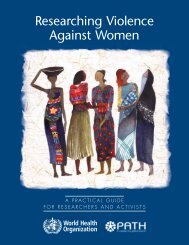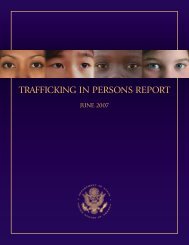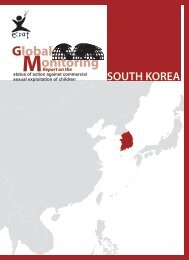Download PDF - Violence Against Children - East Asia and the ...
Download PDF - Violence Against Children - East Asia and the ...
Download PDF - Violence Against Children - East Asia and the ...
Create successful ePaper yourself
Turn your PDF publications into a flip-book with our unique Google optimized e-Paper software.
Vietnam<br />
“Talk is cheap.<br />
Action is expensive.<br />
And <strong>the</strong>re has never<br />
been such a need for<br />
action as now.<br />
Spending money on<br />
children with<br />
disabilities who are<br />
children in especially<br />
difficult<br />
circumstances is one<br />
of society’s most<br />
critical investments<br />
in its future citizens.”<br />
– John Stott, President,<br />
Rehabilitation International,<br />
1995<br />
power to maximise <strong>the</strong> effectiveness of<br />
<strong>the</strong>ir activity. This observation has been<br />
noted in a study by UNICEF in 1994 12<br />
which found that urban projects that worked<br />
closely with people in power (such as <strong>the</strong><br />
mayor’s office) were more effective in<br />
protecting children than projects that did not.<br />
• Potential can be demonstrated clearly of<br />
increased knowledge leading to action. Some<br />
of <strong>the</strong> local <strong>and</strong> district-level governments<br />
provided buildings to <strong>the</strong> project to use as<br />
“<strong>Children</strong>’s Clubs.” This is praiseworthy, as<br />
l<strong>and</strong> is very limited in a place like District 8 in<br />
Ho Chi Minh City; that government provided<br />
a whole building (with ample space) indicates<br />
that <strong>the</strong>y underst<strong>and</strong> <strong>the</strong> value of children<br />
with disabilities (especially <strong>the</strong> intellectually<br />
disabled) having informal education.<br />
• The CBR project maximises its effect through<br />
partnerships <strong>and</strong> volunteers. This increases<br />
local ownership of issues <strong>the</strong> project seeks to<br />
address, <strong>and</strong> children benefit from <strong>the</strong> added<br />
energy <strong>and</strong> interest volunteers bring to <strong>the</strong>ir<br />
roles. Capacity of <strong>the</strong> volunteer, project<br />
partner <strong>and</strong> World Vision alike is increased<br />
through <strong>the</strong> interaction, <strong>and</strong> through followup<br />
of issues that emerge.<br />
Progress has been made through communitybased<br />
rehabilitation so that Article 23 of <strong>the</strong><br />
CRC has more meaning in District 8 in 2002<br />
than it did in 1997. The question has moved<br />
from “what problem?” to how to respond.<br />
Barriers to child protection<br />
<strong>and</strong> participation<br />
• The project operational environment is a<br />
challenge, due to <strong>the</strong> many levels of<br />
permission needed from <strong>the</strong> Government<br />
to conduct a range of activities.<br />
• Holding meetings with volunteers in Vietnam<br />
can be seen as “political” activity, <strong>and</strong> care was<br />
needed in <strong>the</strong> beginning. However, with<br />
greater awareness <strong>and</strong> momentum, meetings<br />
are easily organised. Discussion at communitylevel<br />
meetings, including debates between<br />
government officers <strong>and</strong> volunteers, is<br />
impressive. This is still limited to community<br />
level <strong>and</strong> has not happened at district level.<br />
• Support for <strong>the</strong> intentional inclusion of<br />
children with disabilities in broader<br />
community development projects <strong>and</strong><br />
activities is an ongoing internal barrier. These<br />
children are often forgotten; <strong>the</strong>y are very<br />
much hidden, unable to leave <strong>the</strong>ir homes by<br />
<strong>the</strong>mselves. Unless NGOs (including World<br />
Vision), volunteers <strong>and</strong> local governments<br />
actively enquire about <strong>the</strong> incidence <strong>and</strong><br />
treatment of disability in-community, <strong>the</strong>re is<br />
a risk that <strong>the</strong>y will be excluded from<br />
development. We must all review our<br />
attention to <strong>the</strong>se “invisible children”.<br />
• The involvement of volunteers is a greatly<br />
valued asset. However, it does raise concerns<br />
of adequate support. Better planning <strong>and</strong><br />
policy regarding <strong>the</strong>ir duties <strong>and</strong> <strong>the</strong> hours<br />
involved would assist in giving opportunities<br />
for volunteer development <strong>and</strong> motivation,<br />
<strong>and</strong> should ensure that <strong>the</strong>y are supported<br />
for as long as <strong>the</strong> program continues.<br />
• The funding to develop community-based<br />
services for children (or people) with<br />
disability is often in <strong>the</strong> form of “special<br />
funded” government grants. These special<br />
grants can come with numerous rules,<br />
regulations, guidelines, benchmarks <strong>and</strong><br />
indicators that must be pursued <strong>and</strong> reported<br />
on. Developing grassroots CBR services from<br />
scratch, however, is much more fluid – <strong>the</strong>re<br />
are constantly new learnings, new<br />
circumstances, new opportunities presenting<br />
<strong>the</strong>mselves, new activities needing to be<br />
developed. It can be enormously difficult for a<br />
creative <strong>and</strong> responsive program to meet<br />
inflexible donor requirements.<br />
• Projects assisting children in especially difficult<br />
circumstances or children with disabilities<br />
need access to more flexible grants, or to<br />
alternative funding. They need greater access<br />
to long-term support funding mechanisms,<br />
such as child sponsorship.<br />
12 Blanc, C S,et al., Urban <strong>Children</strong> in Distress, UNICEF, 1994<br />
82

















